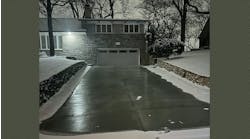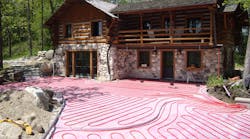Verne Holoubeck managed to buy the rights to the Harley Davidson logo in the mid-90s. It was more like the right to print his own money. Holoubeck cashed out his business in 2005, and in 2010 he was able to splurge on what he calls his “cottage” — a getaway home in the hills of Wisconsin.
But both Holoubeck and his wife are getting up in years, and neither one wanted to be out shoveling or salting their long, winding driveway during the harsh Midwestern winters.
Looking for a solution, the local supply house that was helping build his new home referred him to Cardinal Heating & Air Conditioning, a 28-year-old, second-generation plumbing and heating company.
“We employ right now probably 23 people,” says Craig Ouimette, service manager for Cardinal. “We’re probably 50/50 residential/commercial…We try to keep to within a 60-mile radius of Madison, Wis., but we’ll go further for the right customer.”
The company specializes in hot water heating, solar thermal, solar electric as well as geothermal. And of course, they do radiant work; they are a past winner of the RPA System Design Showcase Award, having received the 2010 Award for Innovation.
“It seems like in the past seven or eight years we’ve been doing quite a bit more radiant,” Ouimette says. “On the new construction side, it’s really taken off…We’ve been doing it in select homes for about 15 years now, and it’s become a word-of-mouth thing. Once you live with radiant heat, you’re going to tell people about it.”
For the Holoubeck home, Cardinal designed a hydronic snow melt system and installed it in the spring of 2011. The system uses a dedicated 400,000 Btuh Weil-McLain boiler, Grundfos pumps and circulators, and tekmar controls.
A 50/50 distilled water/glycol mixture is distributed to a field of 3/4–in. PEX tubing spaced at 9- to 12-in. All together, Cardinal laid out more than 5,000 linear feet of PEX.
“We had two underground manifolds enclosed in concrete,” explains Ouimette. “[The enclosures are] used for underground electrical connections, but we’ve used them in a handful of snowmelt systems, and they work out pretty nice if you’ve got very long runs, basically getting the manifolds further out into the space you need to heat.”
One manifold had eight loops and covered the hill in front of the cabin; the other had seven loops and covered the bottom of the hill leading to the three-car garage.
All the tubing is in-slab, with 4-in. of foam underneath the tubing and another 4-in. of foam sprayed around the outside edges.
The tekmar system uses a cup detector and injection controls to keep from thermally shocking the slab. “When the cup is dry, we can actually set the system to run for an additional time period,” says Ouimette. “We have it set for an hour to get all the drainage off the slab. That way it won’t re-freeze into a big slab of ice.”
Cardinal Heating & Air Conditioning finished the job in two weeks using a three-man crew. “After they laid the foam,” says Ouimette, “it all came together pretty fast.”
Cardinal left a set of closely spaced Ts on the return side of the system to install an alternate heating system at some later date, either a solar collector or a wood gasification boiler. As happy as Holoubeck is with his system and how it operates, he still wishes it didn’t cost so much to run.
After its first full season in operation, Ouimette is happy to report that everything is working just as planned. “I checked on everything for him a few months ago,” Ouimette says, “and it was working fine.”


